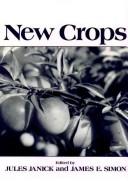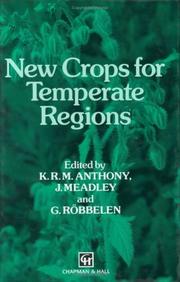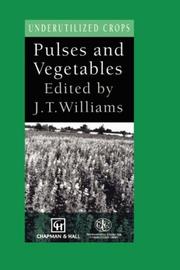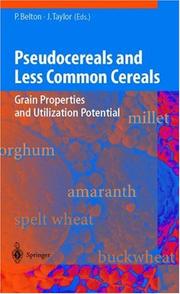| Listing 1 - 10 of 11 | << page >> |
Sort by
|
Periodical
Year: 1999 Publisher: [Washington, D.C.] : [Risk Management Agency],
Abstract | Keywords | Export | Availability | Bookmark
 Loading...
Loading...Choose an application
- Reference Manager
- EndNote
- RefWorks (Direct export to RefWorks)
Crop insurance --- Specialty crops --- New crops

ISBN: 0471593745 Year: 1993 Publisher: New York : Wiley,
Abstract | Keywords | Export | Availability | Bookmark
 Loading...
Loading...Choose an application
- Reference Manager
- EndNote
- RefWorks (Direct export to RefWorks)
New crops --- Plant and Crop Sciences. Crops --- Congresses. --- Crops (General).

ISBN: 0412480204 Year: 1993 Publisher: London ; Glasgow ; New York Chapman & Hall
Abstract | Keywords | Export | Availability | Bookmark
 Loading...
Loading...Choose an application
- Reference Manager
- EndNote
- RefWorks (Direct export to RefWorks)
New crops --- Plant and Crop Sciences. Crops --- Congresses. --- Crops (General) --- Crops (General). --- Congresses --- Europe
Book
ISBN: 9535122797 9535154303 Year: 2016 Publisher: Rijeka, Croatia : InTech,
Abstract | Keywords | Export | Availability | Bookmark
 Loading...
Loading...Choose an application
- Reference Manager
- EndNote
- RefWorks (Direct export to RefWorks)
Cropping systems. --- New crops. --- Alternative agriculture. --- Agriculture --- Agriculture, Alternative --- Alternative agricultural systems --- Alternative farming systems --- Agricultural systems --- Appropriate technology --- Sustainable agriculture --- Crops --- Soil management

ISBN: 0412466104 Year: 1993 Volume: *1 Publisher: London ; Glasgow ; New York Chapman & Hall
Abstract | Keywords | Export | Availability | Bookmark
 Loading...
Loading...Choose an application
- Reference Manager
- EndNote
- RefWorks (Direct export to RefWorks)
New crops --- Nieuwe gewassen --- Nouvelles cultures --- Plant products --- Producten van planten --- Products [Plant ] --- Produits végétaux --- Legumes --- Vegetables --- Utilization --- Legumes. --- Vegetables. --- Social Sciences and Humanities. Development Studies --- Utilization. --- Rural Development --- ETH Ethnobotany & Economic botany --- common agricultural crops --- economic botany --- pulses --- vegetables --- Rural Development.

ISBN: 9783540429395 3540429395 3642076912 3662095440 Year: 2002 Publisher: Berlin : Springer,
Abstract | Keywords | Export | Availability | Bookmark
 Loading...
Loading...Choose an application
- Reference Manager
- EndNote
- RefWorks (Direct export to RefWorks)
This book, written by leading grain scientists from Europe and Africa, examines six such grains that have been important food crops in various parts of the world and have the potential for much greater and more widespread use. The chemistry, nutritional value, food processing technologies and potential applications of three true cereals: sorghum, spelt wheat and the major millet species, and three dicotyledonous pseudocereals: grain amaranth, buckwheat and quinoa are discussed. Just three cereal grains account for more than 75% of all grains produced worldwide. This causes high risks for the future of humankind via catastrophic food crop failures and is detrimental to our long-term health (deficiencies of micronutritients, food allergenes and intolerances). In addition, the intensive cultivation practices needed to produce the required high yields of these cereals is frequently leading to environmental degradation, and they are often inappropriate in the Developing World.
Grain --- New crops --- Céréale --- Cereals --- Pseudocereale --- Pseudocereals --- Composition chimique --- Chemical composition --- Propriété technologique --- technical properties --- Valeur nutritive --- Nutritive value --- Triticum spelta --- Pennisetum glaucum --- Setaria italica --- Eragrostis --- Eleusine coracana --- Sorghum --- Chenopodium quinoa --- Fagopyrum esculentum --- Millets --- Amaranthus --- Produit céréalier --- Cereal products --- Digitaria exilis --- Food—Biotechnology. --- Nutrition . --- Agriculture. --- Soil science. --- Soil conservation. --- Plant ecology. --- Food Science. --- Nutrition. --- Soil Science & Conservation. --- Plant Ecology. --- Botany --- Phytoecology --- Plants --- Vegetation ecology --- Ecology --- Conservation of soil --- Erosion control, Soil --- Soil erosion --- Soil erosion control --- Soils --- Agricultural conservation --- Soil management --- Pedology (Soil science) --- Agriculture --- Earth sciences --- Farming --- Husbandry --- Industrial arts --- Life sciences --- Food supply --- Land use, Rural --- Alimentation --- Food --- Nutrition --- Health --- Physiology --- Diet --- Dietetics --- Digestion --- Food habits --- Malnutrition --- Control --- Prevention --- Conservation --- Health aspects --- Floristic ecology
Multi
ISBN: 906605753X 9066057637 9066057734 9066057831 9066057939 906605803X 9066058137 9066058234 9066058331 9066058439 9066058536 9066058633 9066058730 9066058838 9789066057531 Volume: 511
Abstract | Keywords | Export | Availability | Bookmark
 Loading...
Loading...Choose an application
- Reference Manager
- EndNote
- RefWorks (Direct export to RefWorks)
634 <063> --- Horticulture generally--Congressen --- Conferences - Meetings --- 634 <063> Horticulture generally--Congressen --- Fruit --- Grading --- Quality --- Imagery --- Colour --- 581.143 --- 631.547 --- Academic collection --- 631.547 Phases and control of plant growth --- Phases and control of plant growth --- 581.143 Growth --- Growth --- 634 --- 634 Horticulture generally --- Horticulture generally --- Horticulture --- Economic aspects --- Congresses --- Horticultural products industry --- International cooperation --- Plant biotechnology --- Plant propagation --- In vitro --- Plant molecular biology --- Plant conservation --- New crops --- Botanical gardens --- Plant products --- Horticultural products --- Crops --- Human-plant relationships --- Horticultural crops --- Biotechnology --- Ecology --- Environmental aspects --- Regulation --- Plant regulators --- Plant nutrients --- Plant growing media --- Fertilizers --- Soils --- Nutrition --- Automation --- Information services --- Databases --- Data processing --- Plant gene expression --- Plant genome mapping --- Plant breeding --- Molecular aspects --- Kweken --- Evaluation --- Temperate zone fruit --- Tropics --- Wijnbouw --- Wine and wine making --- Grapes --- Effect of minerals on --- Tropical fruit --- Postharvest physiology --- Postharvest technology --- Bewaring --- Vegetables
Book
ISBN: 3319904728 331990471X Year: 2020 Publisher: Springer International Publishing
Abstract | Keywords | Export | Availability | Bookmark
 Loading...
Loading...Choose an application
- Reference Manager
- EndNote
- RefWorks (Direct export to RefWorks)
This book provides case studies on cultivating alternative crops and presents new cropping systems in many regions of the world. It focusses on new emerging research topics aiming to study all aspects of adaptation under several stresses including agricultural, environmental, biological and socioeconomic issues. The book also provides operational and practical solutions for scientists, producers, technology developers and managers to succeed the cultivation of new alternative crops and, consequently, to achieve food security. Many regions in the world are suffering from water scarcity, soil and water salinization and climate change. These conditions make it difficult to achieve food security by cultivating conventional crops. A renaissance of interest for producing alternative crops under water scarcity and water salinization has been, therefore, implemented primarily among small-scale producers, researchers and academics. The use of alternative crops (quinoa, amaranth, legume crops, halophytes, …etc.) may provide some environmental benefits such as valorization of salt-affected soils, reduced pesticide application, enhanced soil and water quality and promotion of wildlife diversity. This also may provide some economic benefits such as providing the opportunity for producers to take advantage of new markets and premium prices, spreading the economic risk and strengthening local economies and communities. Furthermore, alternative crops are often rich in proteins and minerals, and even some of them are Gluten free (quinoa). This reflects their importance to achieve food security in quantity and quality scale. The year 2013 was exceptional for alternative crops as it was the international year of quinoa celebrated by Food and Agriculture Organization (FAO). This reflects the importance of research conducted on quinoa and other alternative crops in many regions of the world.
Engineering. --- Agriculture. --- Plant physiology. --- Soil science. --- Soil conservation. --- Climate change. --- Environmental management. --- Engineering, general. --- Plant Physiology. --- Soil Science & Conservation. --- Climate Change/Climate Change Impacts. --- Water Policy/Water Governance/Water Management. --- Environmental stewardship --- Stewardship, Environmental --- Environmental sciences --- Management --- Changes, Climatic --- Changes in climate --- Climate change --- Climate change science --- Climate changes --- Climate variations --- Climatic change --- Climatic changes --- Climatic fluctuations --- Climatic variations --- Global climate changes --- Global climatic changes --- Climatology --- Climate change mitigation --- Teleconnections (Climatology) --- Conservation of soil --- Erosion control, Soil --- Soil erosion --- Soil erosion control --- Soils --- Agricultural conservation --- Soil management --- Pedology (Soil science) --- Agriculture --- Earth sciences --- Botany --- Plants --- Physiology --- Farming --- Husbandry --- Industrial arts --- Life sciences --- Food supply --- Land use, Rural --- Construction --- Technology --- Environmental aspects --- Control --- Prevention --- Conservation --- New crops. --- Alternative agriculture. --- Cropping systems. --- Agriculture, Alternative --- Alternative agricultural systems --- Alternative farming systems --- Agricultural systems --- Appropriate technology --- Sustainable agriculture --- Crops
Book
Year: 2020 Publisher: Basel, Switzerland MDPI - Multidisciplinary Digital Publishing Institute
Abstract | Keywords | Export | Availability | Bookmark
 Loading...
Loading...Choose an application
- Reference Manager
- EndNote
- RefWorks (Direct export to RefWorks)
The growing world population exerts tremendous pressure on our finite food resources. Since the lion‘s share of the global calorie intake is reliant upon a handful of plant species like rice, wheat, maize, soybean, and potato, it is the need of the hour to expand our dietary reliance to nutritionally rich but neglected, underutilized, and yet-to-be-used wild plants. Such wild plants also have ethnomedicinal and biocultural significance. Owing to their ecosystem plasticity, they can be easily cultivated in diverse soil systems, including marginal, degraded, and other disturbed areas. Due to these resilient attributes, they can be considered for large-scale cultivation. However, proper biotechnological interventions are important for removing the negative traits as well as for standardizing the mass multiplication and cultivation strategies of such species for various agro-climatic regions. This Special Issue, “Wild Crop Relatives and Associated Biocultural and Traditional Agronomic Practices for Food and Nutritional Security”, was dedicated to showcasing the potential wild crop varieties of nutritional significance and associated biocultural knowledge from the diverse agroecological regions of the world and also to formulating suitable policy frameworks for food and nutritional security. The novel recommendations provided by this Special Issue can serve as a stepping-stone for utilizing wild and neglected crops as supplemental foods.
Research & information: general --- Biology, life sciences --- Technology, engineering, agriculture --- non-domesticated legumes --- Vigna racemosa --- Vigna ambacensis --- Vigna reticulata --- Vigna vexillata --- Tanzania --- wild food legumes --- seed priming --- seaweed extract --- biostimulant --- germination energy --- seedling vigour --- consumer-oriented breeding --- consumer-oriented germplasm conservation --- culinary --- farmer–breeder–chef–consumer nexus --- genetic diversity --- heritage seedbank --- local food systems --- seed-savers --- stress tolerance --- anthropocene --- climate resilient --- food and nutritional security --- resource conservation --- underutilized crops --- Sustainable Development Goals --- biomass --- biochar --- soil --- BPLFA --- FPLFA --- DHA --- ammonia-oxidizing bacteria --- electrophoresis --- genetic resources --- neglected hexaploid wheat --- seed-storage proteins --- Crassocephalum crepidioides --- ethnobotany --- generations --- knowledge dynamics --- Launaea taraxacifolia --- use value --- Vernonia amygdalina --- ascorbic acid --- Diplotaxis erucoides --- field --- greenhouse --- new crops --- nitrates --- sinigrin --- traditional crop varieties --- Jerusalem artichoke --- inulin --- fertilization --- polyphenols --- antioxidant capacity --- climate change scenarios --- climate suitability --- fruit selection index --- Maxent --- species distribution modeling --- pre-breeding --- morphotypes --- domestication index --- indigenous knowledge --- sociolinguistic groups --- client-preferred traits --- seed dormancy --- seed germination --- molecular biology --- genetics --- traditional leafy vegetables --- Gynandropsis gynandra --- undomesticated legumes --- legumes --- Vigna species --- domestication --- unexplored legumes --- induced mutation --- lodging resistance --- photosynthetic efficiency --- transcriptomics --- orphan crops --- neglected and underutilized species --- wild edibles --- biodiversity --- food composition --- nutrition --- policy --- breeding --- Macrotyloma geocarpum --- farmers’ preferences --- cropping systems --- constraints --- cultivar development --- landraces --- conservation --- agrobiodiversity --- biocultural knowledge --- crop improvement --- dietary diversification --- field gene banks --- planetary healthy diet --- traditional agronomic practices --- non-domesticated legumes --- Vigna racemosa --- Vigna ambacensis --- Vigna reticulata --- Vigna vexillata --- Tanzania --- wild food legumes --- seed priming --- seaweed extract --- biostimulant --- germination energy --- seedling vigour --- consumer-oriented breeding --- consumer-oriented germplasm conservation --- culinary --- farmer–breeder–chef–consumer nexus --- genetic diversity --- heritage seedbank --- local food systems --- seed-savers --- stress tolerance --- anthropocene --- climate resilient --- food and nutritional security --- resource conservation --- underutilized crops --- Sustainable Development Goals --- biomass --- biochar --- soil --- BPLFA --- FPLFA --- DHA --- ammonia-oxidizing bacteria --- electrophoresis --- genetic resources --- neglected hexaploid wheat --- seed-storage proteins --- Crassocephalum crepidioides --- ethnobotany --- generations --- knowledge dynamics --- Launaea taraxacifolia --- use value --- Vernonia amygdalina --- ascorbic acid --- Diplotaxis erucoides --- field --- greenhouse --- new crops --- nitrates --- sinigrin --- traditional crop varieties --- Jerusalem artichoke --- inulin --- fertilization --- polyphenols --- antioxidant capacity --- climate change scenarios --- climate suitability --- fruit selection index --- Maxent --- species distribution modeling --- pre-breeding --- morphotypes --- domestication index --- indigenous knowledge --- sociolinguistic groups --- client-preferred traits --- seed dormancy --- seed germination --- molecular biology --- genetics --- traditional leafy vegetables --- Gynandropsis gynandra --- undomesticated legumes --- legumes --- Vigna species --- domestication --- unexplored legumes --- induced mutation --- lodging resistance --- photosynthetic efficiency --- transcriptomics --- orphan crops --- neglected and underutilized species --- wild edibles --- biodiversity --- food composition --- nutrition --- policy --- breeding --- Macrotyloma geocarpum --- farmers’ preferences --- cropping systems --- constraints --- cultivar development --- landraces --- conservation --- agrobiodiversity --- biocultural knowledge --- crop improvement --- dietary diversification --- field gene banks --- planetary healthy diet --- traditional agronomic practices
Book
Year: 2020 Publisher: Basel, Switzerland MDPI - Multidisciplinary Digital Publishing Institute
Abstract | Keywords | Export | Availability | Bookmark
 Loading...
Loading...Choose an application
- Reference Manager
- EndNote
- RefWorks (Direct export to RefWorks)
The growing world population exerts tremendous pressure on our finite food resources. Since the lion‘s share of the global calorie intake is reliant upon a handful of plant species like rice, wheat, maize, soybean, and potato, it is the need of the hour to expand our dietary reliance to nutritionally rich but neglected, underutilized, and yet-to-be-used wild plants. Such wild plants also have ethnomedicinal and biocultural significance. Owing to their ecosystem plasticity, they can be easily cultivated in diverse soil systems, including marginal, degraded, and other disturbed areas. Due to these resilient attributes, they can be considered for large-scale cultivation. However, proper biotechnological interventions are important for removing the negative traits as well as for standardizing the mass multiplication and cultivation strategies of such species for various agro-climatic regions. This Special Issue, “Wild Crop Relatives and Associated Biocultural and Traditional Agronomic Practices for Food and Nutritional Security”, was dedicated to showcasing the potential wild crop varieties of nutritional significance and associated biocultural knowledge from the diverse agroecological regions of the world and also to formulating suitable policy frameworks for food and nutritional security. The novel recommendations provided by this Special Issue can serve as a stepping-stone for utilizing wild and neglected crops as supplemental foods.
non-domesticated legumes --- Vigna racemosa --- Vigna ambacensis --- Vigna reticulata --- Vigna vexillata --- Tanzania --- wild food legumes --- seed priming --- seaweed extract --- biostimulant --- germination energy --- seedling vigour --- consumer-oriented breeding --- consumer-oriented germplasm conservation --- culinary --- farmer–breeder–chef–consumer nexus --- genetic diversity --- heritage seedbank --- local food systems --- seed-savers --- stress tolerance --- anthropocene --- climate resilient --- food and nutritional security --- resource conservation --- underutilized crops --- Sustainable Development Goals --- biomass --- biochar --- soil --- BPLFA --- FPLFA --- DHA --- ammonia-oxidizing bacteria --- electrophoresis --- genetic resources --- neglected hexaploid wheat --- seed-storage proteins --- Crassocephalum crepidioides --- ethnobotany --- generations --- knowledge dynamics --- Launaea taraxacifolia --- use value --- Vernonia amygdalina --- ascorbic acid --- Diplotaxis erucoides --- field --- greenhouse --- new crops --- nitrates --- sinigrin --- traditional crop varieties --- Jerusalem artichoke --- inulin --- fertilization --- polyphenols --- antioxidant capacity --- climate change scenarios --- climate suitability --- fruit selection index --- Maxent --- species distribution modeling --- pre-breeding --- morphotypes --- domestication index --- indigenous knowledge --- sociolinguistic groups --- client-preferred traits --- seed dormancy --- seed germination --- molecular biology --- genetics --- traditional leafy vegetables --- Gynandropsis gynandra --- undomesticated legumes --- legumes --- Vigna species --- domestication --- unexplored legumes --- induced mutation --- lodging resistance --- photosynthetic efficiency --- transcriptomics --- orphan crops --- neglected and underutilized species --- wild edibles --- biodiversity --- food composition --- nutrition --- policy --- breeding --- Macrotyloma geocarpum --- farmers’ preferences --- cropping systems --- constraints --- cultivar development --- landraces --- conservation --- agrobiodiversity --- biocultural knowledge --- crop improvement --- dietary diversification --- field gene banks --- planetary healthy diet --- traditional agronomic practices
| Listing 1 - 10 of 11 | << page >> |
Sort by
|

 Search
Search Feedback
Feedback About UniCat
About UniCat  Help
Help News
News